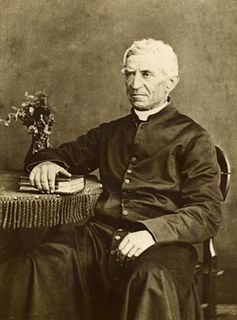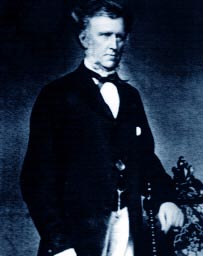Related Research Articles
William Sykes was an English convict, transported to Western Australia for manslaughter.
Daniel Connor was a convict transported to Western Australia, who became one of the wealthiest men in the colony.
John Murgatroyd Hubbard was a convict transported to Western Australia, and later became one of the colony's ex-convict school teachers.

Newcastle Hospital in Toodyay, Western Australia was completed in 1894 and was the only purpose built hospital for the town then known as Newcastle.

Dr Growse's House is located on Stirling Terrace in Toodyay, Western Australia and was constructed in the early 1860s, possibly with convict labour.
The Roman Catholic Church Group, Toodyay is a site on Stirling Terrace in Toodyay, Western Australia, owned by the Catholic Church. This site was registered as Roman Catholic land in November 1861 in the newly proclaimed Avon District town of Newcastle. These buildings were erected here between the early 1860s and 1963:

The town of Toodyay, Western Australia, was not always known by that name. Initially Toodyay was located in what is now West Toodyay before repeated flooding caused the town centre to migrate to the area around the Newcastle convict depot creating the town of Newcastle. After approximately 50 years of confusion the name of Newcastle was changed to Toodyay and the original Toodyay became known as West Toodyay.
Joseph Strelley Harris (1811–1889) was a pastoralist in Western Australia. Between 1840 and 1888, he was a resident magistrate, serving in the towns of Williams, Toodyay, Busselton and Kojonup.

Canon Raffaele Martelli was Toodyay's first Catholic priest. He was a scholarly and gentle man who was much loved by settlers of all faiths. Martelli did not keep a diary, but his personality and humour shines through his regular correspondence with his friend Bishop Rosendo Salvado of New Norcia. His letters from Toodyay reveal the day-to-day travails of a priest who started out with no house or church. He had to rely on the goodwill of his parishioners for a roof over his head and food on the table, while a pair of woollen winter socks from Salvado brought him untold joy.
Michael Clarkson was one of the early settlers in the Swan River Colony and the Avon region of Western Australia.
William Amed Demasson, a carpenter and wheelwright by trade, was one of Toodyay's citizens who made a substantial contribution to the civic life of the town. Among the many organizations that he belonged to, he is particularly associated with the formation of a branch of the Independent Order of Oddfellows Manchester Unity in Toodyay, or Newcastle, as it was known at the time.
William Mayhew was a medical practitioner in the Toodyay district of Western Australia. Mayhew was appointed medical officer for Toodyay in 1872 when the previous doctor, Arthur Edwardes Growse was transferred to Guildford. His original vocation was that of a teacher, and he and his wife Alicia had come to Western Australia to take up appointments in this profession. It is assumed that Mayhew had acquired his medical training in England before his arrival in Western Australia in 1867.
Owen Hackett (1809–1862) was one of a number of Enrolled Pensioner Guards (EPGs) that came to the Swan River Colony between 1850 and 1868. Their role was to guard and oversee the work of the prisoners transported to Western Australia.
Francis Kirk was one of a number of Enrolled Pensioner Guards (EPGs) who came to the Swan River Colony between 1850 and 1868, to guard and oversee the work of the prisoners transported to Western Australia.
John Acton Wroth (1830–1876) was a convict transportee to the Swan River Colony, and later a clerk and storekeeper in Toodyay, Western Australia. He kept a personal diary that recorded life on board the transport ship and his experiences at the country hiring depots of York and Toodyay. This diary is lodged in the archives of the State Library.
David Gailey (1807–1881) was one of a number of Enrolled Pensioner Guards (EPGs) who came to the Swan River Colony between 1850 and 1868. Their role was to guard and oversee the work of the prisoners transported to Western Australia.
Charles Harper was Toodyay's first Anglican minister, and the first ordinand from Western Australia. While being a minister of the church was probably far from his intentions when he set sail for the Swan River Colony in 1837, his family's clerical background and his own disposition suited him well for this vocation. Harper served the Toodyay district for over 30 years, first as registrar of births, deaths and marriages, then from 1849 as an ordained minister.

In 1851, the Toodyay Convict Hiring Depot was set up in the original township of Toodyay, now called West Toodyay. Temporary accommodation for the Enrolled Pensioner Guards was also constructed and surveys were carried out to enable more permanent accommodation to be built close by. The Enrolled Pensioner Guards were men who had either completed their duty of service or who had sustained injury while on active service. They had then volunteered as guards on the ships transporting convicts to Western Australia. Once the men were released from permanent duty, other duties of a peace keeping or military nature were expected of them. Many of these men became warders in charge of convicts.
The Church of Sancta Maria was the first Catholic church built in the original townsite of Toodyay in Western Australia. It was consecrated in 1859, and served as church, priest's residence, and schoolhouse for the Toodyay Valley Catholic School. It later housed the Toodyay Valley government school.
Construction of the new Toodyay Convict Hiring Depot began in February 1852 and was completed by 1856. The depot was closed in 1872. The site chosen, Avon Location 110, was an area of Crown land measuring just over 45 acres (18 ha). It was situated approximately 3 miles (4.8 km) upstream from the site of the previous Toodyay Convict Hiring Depot (1851) located at the Toodyay townsite. The previous depot had only ever been a temporary arrangement born of necessity when accommodation was required at short notice. The new depot site was surveyed by Francis Thomas Gregory in 1852.
References
![]()
- 1 2 "Country News". The West Australian. 1931-04-30. p. 12. Retrieved 2015-10-27.
- ↑ Erickson, Rica (1974). Old Toodyay and Newcastle. Toodyay Shire Council. ISBN 0959831509.
- ↑ "Newcastle (Communicated.)". 1877-11-10. p. 2. Retrieved 2015-10-27.
- Toodyay Medical and Allied Services Chronology, compiled by Beth Frayne, Toodyay Historical Society.
- Rica Erickson (1988). The Bicentennial Dictionary of Western Australians: pre-1829 – 1888. 2 D–J. University of Western Australia Press. p. 1290. ISBN 0 85564 273 4 . Retrieved 2018-05-05.